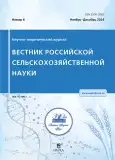Особенности фауны и биотопического распределения кровососущих мошек (Diptera: Simuliidae) в Тюменской области, как потенциальных переносчиков туляремии
- Авторы: Фёдорова О.А.1
-
Учреждения:
- Всероссийский научно-исследовательский институт ветеринарной энтомологии и арахнологии-филиал Федерального государственного бюджетного учреждения науки федерального исследовательского центра Тюменского научного центра Сибирского отделения Российской академии наук
- Выпуск: № 6 (2024)
- Страницы: 104-107
- Раздел: Ветеринарная энтомология
- URL: https://journal-vniispk.ru/2500-2082/article/view/274624
- DOI: https://doi.org/10.31857/S2500208224060224
- EDN: https://elibrary.ru/WSJHBZ
- ID: 274624
Цитировать
Аннотация
В статье представлен комплексный эпидемиологический анализ семейства кровососущих мошек (Diptera: Simuliidae). Эти насекомые передают патогены человеку и животным, включая вирусы, бактерии и простейших. Рассмотрено их распространение, сезонная динамика и предпочтительные места обитания, а также эпидемиологическое значение в различных географических регионах. Исследование направлено на информирование и руководство в области общественного здравоохранения для разработки более эффективных стратегий контроля и профилактики заболеваний, передаваемых кровососущими мошками. Изменение состояния региональных фаун, сопряженное со смещением границ ареалов видов, может быть объяснено как антропогенным преобразованием ландшафтов, так и динамикой климата. Из выявленного нами списка кровососущих мошек, обитающих на территории Тюменской области, потенциальные переносчики возбудителей туляремии – B. maculatus, Sch. рusilla, что согласуется с литературными данными.
Ключевые слова
Полный текст
Об авторах
Ольга Александровна Фёдорова
Всероссийский научно-исследовательский институт ветеринарной энтомологии и арахнологии-филиал Федерального государственного бюджетного учреждения науки федерального исследовательского центра Тюменского научного центра Сибирского отделения Российской академии наук
Автор, ответственный за переписку.
Email: fiodorova-olia@mail.ru
ORCID iD: 0000-0002-0589-2373
кандидат биологических наук, ведущий научный сотрудник
Россия, ТюменьСписок литературы
- Веселкин Г.А. Особенности локализации некоторых кровососущих двукрылых насекомых на теле хозяев // Мат. I Всерос. совещ. по кровососущим насекомым (Санкт – Петербург, 24–27 октября 2006 г.). СПб, 2006. С. 42–44.
- Государственный доклад о состоянии санитарно-эпидемиологического благополучия населения в Воронежской области в 2013 году. Воронеж: Управление Федеральной службы по надзору в сфере защиты прав потребителей и благополучия человека по Воронежской области, 2014. 233 с.
- Кудрявцева Т.Ю., Мокриевич А.Н. Эпидемическая активность природных очагов туляремии на территории Российской Федерации в 2018 г. и прогноз ситуации на 2019 г. // Проблемы особо опасных инфекций. 2019. № 1. С. 32–41.
- Медведев С.Г., Айбулатов С.В. Фауна кровососущих насекомых комплекса гнуса (Diptera) ленинградской области и Санкт-Петербурга // Паразитология. 2012. Т. 46. № 5. С. 350–368.
- Мещерякова И.С., Туляремия. В кн.: Природная очаговость болезней: исследования института Гамалеи РАМН. М., 2003. С. 137–160.
- Derya Karataş Yeni, Fatih Büyük, Asma Ashraf, M Salah Ud Din Shah. Tularemia: a re-emerging tick-borne infectious disease // Folia Microbiol (Praha). 2021. № 66(1). Р. 1–14. https://doi.org/10.1007/s12223-020-00827-z
- Fooladfar Z., Moradi F. Francisella and tularemia in western Asia, Iran: a systematic review // New Microbes New Infect. 2023. https://doi.org/10.1016/j.nmni.2023.101092.
- Oyston P.C.F., Green M., Titball R.W. Tularemia Clin Microbiol Rev. 2002. № 15(4). Р. 631–646. https://doi.org/10.1128/CMR.15.4.631-646.2002
Дополнительные файлы










